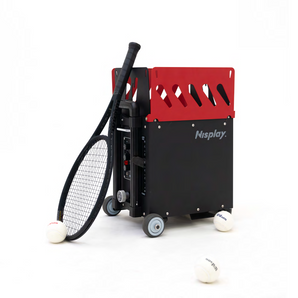Tennis, a sport steeped in history and elegance, has evolved from its humble beginnings in 12th century France to become a global phenomenon admired by millions. This article delves into 50 fascinating facts about tennis, offering a comprehensive overview of its rich heritage, unique aspects, and significant impact on culture and society. From the prestigious grass courts of Wimbledon to the high-tech rackets used by today's champions, these facts shed light on the intricacies and allure of a sport that has captivated audiences for centuries. Whether you're a seasoned player, an enthusiastic fan, or simply curious about the game, these insights will enhance your appreciation for the world of tennis.
- Origin: Tennis originated in France in the 12th century.
- Original Name: It was originally called “jeu de paume” (game of the palm).
- First Tennis Rackets: Early rackets were made of wood and strings were made of gut.
- Wimbledon: The oldest tennis tournament in the world is Wimbledon, started in 1877.
- Grand Slam Tournaments: There are four Grand Slam tournaments: Wimbledon, the US Open, the French Open, and the Australian Open.
- Surface Variety: Tennis is played on different surfaces: grass, clay, hard court, and carpet.
- Olympic Sport: Tennis was reintroduced as an Olympic sport in 1988.
- Scoring System: The unique scoring system (love, 15, 30, 40) has origins in medieval France.
- Tennis Balls: Originally, tennis balls were white. Yellow balls were introduced in 1972 to make them more visible on TV.
- Longest Match: The longest match ever played was 11 hours and 5 minutes at Wimbledon in 2010.
- String Tension: Professional players often customize their racket’s string tension to their liking.
- Tie-Break: The tie-break was invented in 1965 to prevent excessively long matches.
- Speed of Serve: The fastest recorded tennis serve is 263.4 km/h (163.7 mph) by Samuel Groth.
- Tennis Elbow: Lateral epicondylitis, commonly known as tennis elbow, is a frequent injury among players.
- No Clocked Time: Unlike many sports, tennis has no clock; matches can vary greatly in length.
- Ball Changes: In professional matches, tennis balls are typically changed every 7-9 games.
- Golden Slam: Winning all four Grand Slams and Olympic gold in the same year is called a "Golden Slam".
- Davis Cup: The Davis Cup is the premier international team event in men's tennis.
- Fed Cup: The Fed Cup is the equivalent of the Davis Cup for women’s tennis.
- Court Size: A standard tennis court measures 78 feet long and 27 feet wide for singles matches.
- Open Era: The "Open Era" began in 1968 when Grand Slam tournaments agreed to allow professional players to compete with amateurs.
- Two-handed Backhand: The two-handed backhand was popularized by Bjorn Borg in the 1970s.
- Ball Boys and Girls: Wimbledon uses about 250 ball boys and girls during the tournament.
- Hawk-Eye Technology: Hawk-Eye technology is used for challenging line calls.
- Underhand Serve: An underhand serve, while rare and sometimes seen as unsporting, is legal.
- Grass Court Speed: Grass courts are the fastest type of courts in tennis.
- Clay Court Slowness: Clay courts are slower and allow for a higher bounce of the ball.
- Equal Prize Money: Wimbledon began offering equal prize money to men and women in 2007.
- Indoor Tennis: The first indoor tennis match was played in 1898.
- First Tennis Championships: The U.S. National Men’s Singles Championship, now the US Open, was first held in 1881.
- Tennis Fashion: Tennis has its own fashion evolution, from long skirts and trousers to modern athletic wear.
- Youngest Grand Slam Winner: Martina Hingis won Wimbledon at 15 years old.
- Oldest Grand Slam Winner: Ken Rosewall won the 1972 Australian Open at 37 years old.
- Wheelchair Tennis: Wheelchair tennis follows the same rules as able-bodied tennis, except the ball can bounce twice.
- Rubber Core: Tennis balls have a rubber core covered with a fibrous felt.
- Serve Clock: A serve clock was introduced to professional tennis in 2018 to speed up the game.
- Tennis in Literature: Tennis is featured in literature, most notably in Shakespeare’s “Henry V”.
- First African American Champion: Althea Gibson was the first African American to win a Grand Slam title.
- Graphene Rackets: The newest tennis rackets are made with graphene for lighter weight and strength.
- Tennis in Space: Tennis was played in space for the first time in 2018 on the International Space Station.
- Tennis Court Oath: The Tennis Court Oath was a key event in the French Revolution and occurred on a tennis court.
- Match Fixing Scandals: Tennis has faced its share of match-fixing scandals over the years.
- Global Popularity: Tennis is one of the most popular individual sports worldwide.
- Tennis Video Games: Tennis has been popular in video games, with titles like Wii Sports and Virtua Tennis.
- Tennis in Movies: Tennis has been featured in many movies, like “Wimbledon” and “Battle of the Sexes”.
- Gender Controversies: The sport has seen its share of gender controversies, including debates over equal pay.
- Sponsorships and Endorsements: Top tennis players earn significant income from sponsorships and endorsements.
- Environmental Impact: Tennis faces challenges in reducing its environmental impact, including the disposal of tennis balls.
- Tennis and Royalty: Tennis has historical connections with royalty, especially in Europe.
- Cultural Impact: Tennis has influenced fashion, language, and culture beyond the sport itself.









